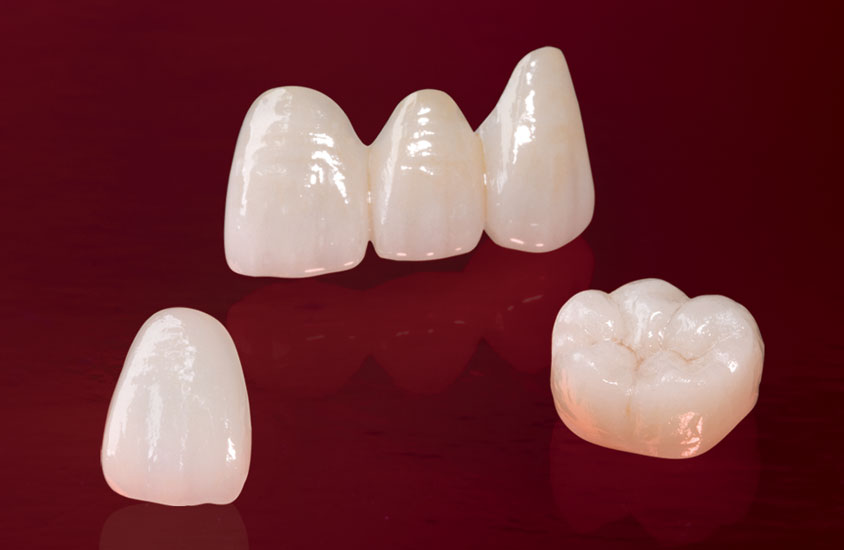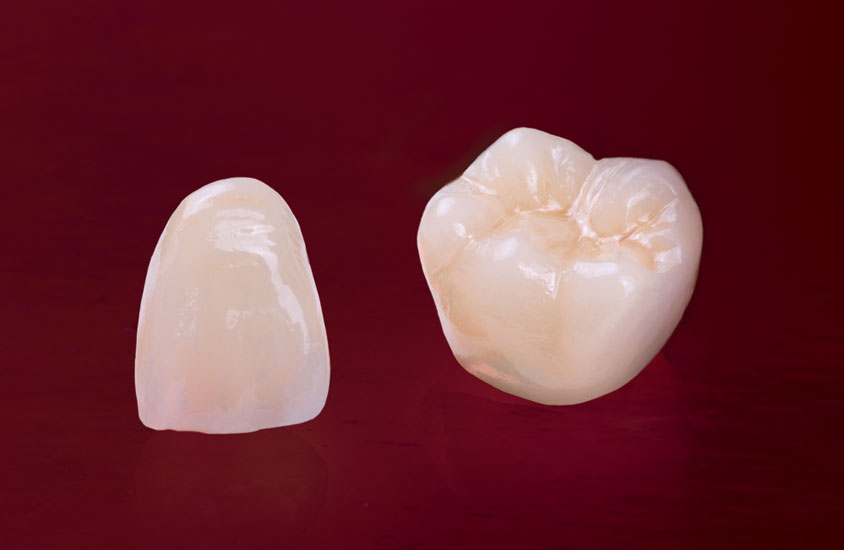
When a Filling, Onlay or Veneer is not a viable option then a Crown is recommended. Our goal is to restore your mouth with the least invasive and most conservative restorative option first. We diagnose and recommend a crown only if a more conservative restoration is not an option.
Smaller restorations (least invasive)
- Filling
- Inlay | Onlay | Veneer
- 3/4 Crown
- Crown
Larger restorations (usually more invasive but not excessive)
Crown
How do Crowns Work?
A dental crown is a fixed restoration option made of various materials most commonly porcelain, or a combination of porcelain and metal covering the entire tooth. This will then strengthen the tooth structure, restore your bite and match the aesthetics of your other teeth. Crowns are a commonly prescribed to restore and support damaged, broken, or decayed teeth. We use customized shade matching, the highest quality name brand porcelain and materials in the industry.
A crown may be recommended to:
Restore a tooth with large decay, if an Onlay is not possible to place.
Protect a weak tooth from fracturing
Restore a fractured tooth
Attach a bridge to provide an anchor for a partial denture or bridge
Restore a dental implant
Restore a discolored or poorly shaped tooth when a veneer is not possible
Restore a tooth that has had root canal treatment
Bridge
Note: When an implant is not possible or not indicated we can extract a tooth and place a bridge immediately after the extraction. This means a patient can come in with a hopeless tooth, have it extracted and leave with a replacement temporary tooth in a few hours. This temporary bridge / tooth will be fixed and not removable.
How do Bridges Work?
Bridges are similar to crowns, yet they replace missing teeth by using the neighboring teeth to bridge the gap. They can replace one or multiple teeth next to each other. Unlike partial dentures, a bridge is cemented fixed in your mouth. When multiple teeth are damaged and need to be replaced, porcelain bridges are a great option. Bridges also can save you time and money when compared to dental implants.
To fabricate bridges, impressions of our patient’s current teeth are taken and scanned to determine space and position. A temporary bridge is placed on the teeth to provide essential functionality and aesthetics while the permanent bridge is being created. After a waiting period, the final porcelain fused to metal bridge is then delivered.
Both crowns and most bridges are fixed prosthetic devices. Unlike removable devices such as dentures, which you can take out and clean daily, crowns and bridges are cemented onto existing teeth or implants, and can only be removed by a dentist.
How are Crowns and Bridges Made?
Before either a crown or a bridge can be made, the tooth (or teeth) must be reduced in size so that the crown or bridge will fit over it properly. After reducing the tooth | teeth, your dentist will take an impression to provide an exact mold for the crown or bridge. If porcelain is to be used, your dentist will determine the correct shade for the crown or bridge to match the color of your existing teeth.
Using this impression, our on premise dental lab then makes your crown or bridge, in the material your dentist specifies. A temporary crown or bridge will be put in place to cover the prepared tooth while the permanent crown or bridge is being made. When the permanent crown or bridge is ready, the temporary crown or bridge is removed, and the new crown or bridge is cemented over your prepared tooth or teeth.
How Long Do Crowns and Bridges Last?
While crowns and bridges can last a longtime, on average 10 to 15 years but often last longer. They do sometimes come loose or fall out. The most important step you can take to ensure the longevity of your crown or bridge is to practice good oral hygiene. A bridge can lose its support if the teeth or bone holding it in place are damaged by dental disease. Keep your gums and teeth healthy by brushing with fluoride toothpaste twice a day and flossing daily. Also see your dentist and hygienist regularly for checkups and professional cleanings.
Possible Drawbacks
A bridge is often prescribed as an alternative to implants, if an implant or implants are not possible or high risk. Although bridges work well and have been proven to work many years (10 to 15 on average) they do have some drawbacks just like any other alternative restoration would.
- More difficult to clean, can’t floss thoroughly due to teeth in bridge are connected. Can floss under bridge with floss threader, water floss or? brush.
- A bridge is not recommended as the best option if the adjacent / anchoring teeth (abutments) are natural or healthy.
- If you have a problem with one tooth, sometimes the entire bridge will have to be replaced.
Post Op Care for: Crowns and Bridges
When anesthesia has been used, your lips, teeth, and tongue may be numb for 2 to 3 hours after the appointment. We recommend that you avoid eating or chewing until the numbness has completely worn off. It is easy to bite or burn your tongue and lip while numb. It is recommended (if patient is not allergic) that you take some ibuprofen (Motrin or Advil, 1-2 tablets every 4-6 hours as needed) before the anesthetic completely wears off. This will help with any swelling or pain at the injection sites where your anesthetic was administered. Ask us and we can prescribe pain medication for you if needed.
- The gum tissue around the prepared teeth may be sore for several days. You may rinse your mouth with warm salt water (put a ½ teaspoon of salt in a cup of warm water, rinse and spit. do not swallow) to reduce pain and swelling.
- Crowns and bridges usually take two appointments to complete. At the first visit, the teeth are prepared and a temporary crown or bridge is placed with temporary cement while awaiting the final restoration. The temporary restoration not only protects the tooth from damage, but it also prevents it from shifting position, helps the gum tissue to heal in the proper location, and provides a cosmetic solution until the permanent restoration can be placed.
- Your tooth may feel sensitive to temperature, sweets, or biting. This is normal and should subside in a few days. If this sensitivity is severe and does not dissipate, please contact our office immediately.
- Please call our office if your bite feels uneven, so that we can adjust your temporary crown.
- Do not eat anything sticky, hard or chewy as this may pull the temporary off or break it. Be careful brushing and avoid flossing adjacent to the temporary as this may cause it to become dislodged. Once the permanent restoration is placed, you should brush and floss normally. Should a temporary inadvertently come off, contact our office immediately to have it re-cemented.
